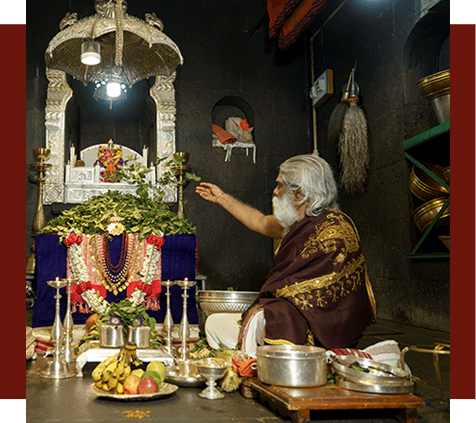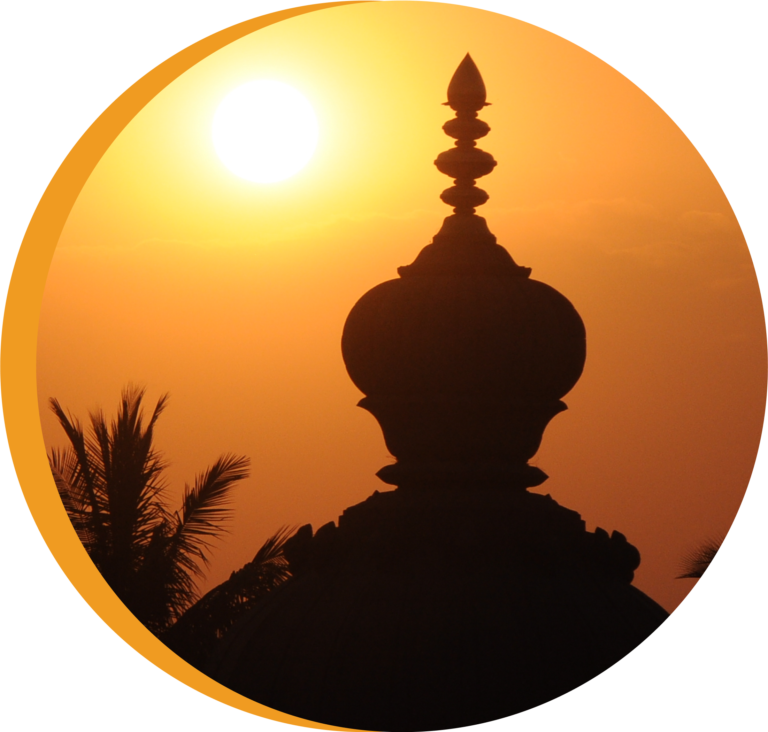
Maniknagar
Maniknagar
- How to reach
- Things to see
- Events and Festival
- Activities
- ebook & Downloads
Datta Jayanti
Datta Jayanti


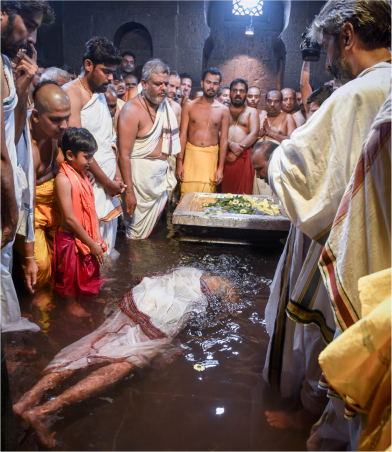
Teertha Snaan & Yogadanda Poojan
The beginning of the festivities is marked with a Ritual Purification ceremony. Hundreds of devotees volunteer in the cleaning of the entire Manik Prabhu Temple Complex. The Sanctum Sanctorum or the Garbha Griha of Shri Prabhu Mandir is specially washed amidst chanting of the Mahamantra. After it is thoroughly washed, the Garbha Griha is filled with water up to a level at which the Samadhi of Shri Manik Prabhu Maharaj is partially submerged. The water thus filled surrounds the holy Samadhi of Shri Prabhu. Since it comes into contact with Shri Prabhu’s Samadhi it no longer remains plain water but transforms itself into Teertha, which has the potential of washing away our sins and impurities. Shreeji, after performing Aarati to Shri Prabhu, performs Teertha Snaan by prostrating before the Samadhi in the holy water. With him, hundreds of devotees also take a dip in the holy water. This is symbolic of a cleansing of our inner (spiritual) and outer (corporeal) selves which is a pre-requisite for any kind of worship or ritual. There are around 1300 wooden batons or Yoga Dandas which Shri Prabhu had specially got prepared from his followers since they always accompanied him in
his sojourn in jungles and woods with the fear of attack from wild animals and thugs always looming over their heads. The distribution of Yoga Dandas by Shri Prabhu among his followers also had another angle to it. It was a period of mass unrest as the first war of independence had been waged against the British by Tatya Tope, Rani Lakshmi Bai, and other nationalists. The Nizam of Hyderabad, in whose dominion Maniknagar fell, was a faithful ally of the British Government and his army and police always nursed a doubt that Shri Prabhu, with his hundreds of followers, was sympathetic to the cause of the freedom struggle and was always conspiring to destabilize the government of the day. It is said that Shri Prabhu touched each one of the sticks, thus equipping them with his yogic power of protection and handed them to his followers on the condition that they would be promptly returned to him when they felt that they no longer required them. All these 1300 wooden sticks or Yoga Dandas are meticulously preserved to this day. They are taken out once in a year, on this day, in the presence of Shreeji, cleaned, embalmed with a preservative oil and kept back in their original place. Devotees participate in this process and feel blessed by touching the Yoga Dandas which once had the holy touch of Shri Prabhu.

Teertha Snaan & Yogadanda Poojan
The beginning of the festivities is marked with a Ritual Purification ceremony. Hundreds of devotees volunteer in the cleaning of the entire Manik Prabhu Temple Complex. The Sanctum Sanctorum or the Garbha Griha of Shri Prabhu Mandir is specially washed amidst chanting of the Mahamantra. After it is thoroughly washed, the Garbha Griha is filled with water up to a level at which the Samadhi of Shri Manik Prabhu Maharaj is partially submerged. The water thus filled surrounds the holy Samadhi of Shri Prabhu. Since it comes into contact with Shri Prabhu’s Samadhi it no longer remains plain water but transforms itself into Teertha, which has the potential of washing away our sins and impurities. Shreeji, after performing Aarati to Shri Prabhu, performs Teertha Snaan by prostrating before the Samadhi in the holy water. With him, hundreds of devotees also take a dip in the holy water. This is symbolic of a cleansing of our inner (spiritual) and outer (corporeal) selves which is a pre-requisite for any kind of worship or ritual. There are around 1300 wooden batons or Yoga Dandas which Shri Prabhu had specially got prepared from his followers since they always accompanied him in his sojourn in jungles and woods with the fear of attack from wild animals and thugs always looming over their heads. The distribution of Yoga Dandas by Shri Prabhu among his followers also had another angle to it. It was a period of mass unrest as the first war of independence had been waged against the British by Tatya Tope, Rani Lakshmi Bai, and other nationalists. The Nizam of Hyderabad, in whose dominion Maniknagar fell, was a faithful ally of the British Government and his army and police always nursed a doubt that Shri Prabhu, with his hundreds of followers, was sympathetic to the cause of the freedom struggle and was always conspiring to destabilize the government of the day. It is said that Shri Prabhu touched each one of the sticks, thus equipping them with his yogic power of protection and handed them to his followers on the condition that they would be promptly returned to him when they felt that they no longer required them. All these 1300 wooden sticks or Yoga Dandas are meticulously preserved to this day. They are taken out once in a year, on this day, in the presence of Shreeji, cleaned, embalmed with a preservative oil and kept back in their original place. Devotees participate in this process and feel blessed by touching the Yoga Dandas which once had the holy touch of Shri Prabhu.
Ganapati Homam & Sakal Devata Nimantran
This is the day of invoking the blessings of the deities for the successful completion of the Mahotsava. There are around 13 temples in Maniknagar. Shreeji visits each one of these temples and performs pooja to the presiding deities and seeks there divine blessings for starting the Mahotsava. A Ganapati Homa is also performed on this occasion for an auspicious start to the proceedings of the Mahotsava.
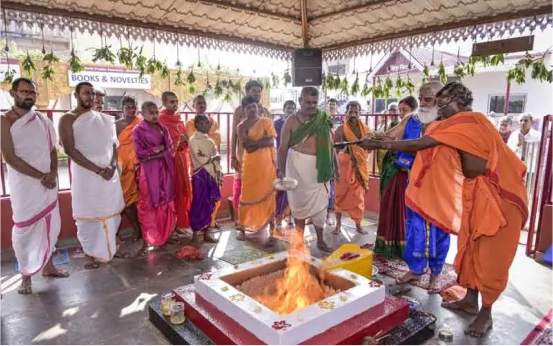

Ganapati Homam & Sakal Devata Nimantran
This is the day of invoking the blessings of the deities for the successful completion of the Mahotsava. There are around 13 temples in Maniknagar. Shreeji visits each one of these temples and performs pooja to the presiding deities and seeks there divine blessings for starting the Mahotsava. A Ganapati Homa is also performed on this occasion for an auspicious start to the proceedings of the Mahotsava.


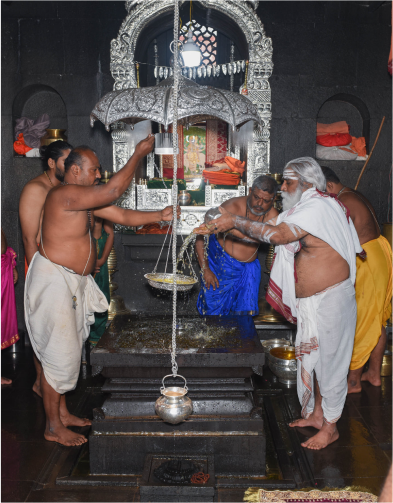
Prabhu Punyatithi
One should personally see this Rajopachar Mahapooja or the royal ritual? to understand why Shri Prabhu is called Rajadhiraj? The eleventh day of the Hindu month of Margasheersha is the day when Shri Prabhu decided to bring curtains down on his corporeal existence and entered into the state of Sanjivini Maha Samadhi. This day is also important for the reason that it is the day when Bhagwan Shri Krishna preached the life-transforming message of Gita to his confused but proficient disciple Arjuna. Shri Prabhu thought there was no better occasion than this (Geeta Jayanti) to transcend the realm of the physical world and make himself a part of the universal conscience by entering into Maha Samadhi. In the wee hours of this day, he took Sanyas Deeksha (the highest state of renunciation), sat in the yogic posture of Padmasana in the pit that had been very secretly prepared inside his hut by his very close and confidant shishyas and began to meditate. As instructed by Shri Prabhu, his followers closed the pit from above as soon as they got the signal from Shri Prabhu. A Rajopachar Mahapooja is performed on this day by Shreeji to Shri Prabhu? Samadhi. This Pooja, as its name suggest, is truly a royal affair.All the privileges, services and honors that are generally meant for a king are offered at the lotus feet of Shri Prabhu.
(the king among kings) or Yogi-Maharaj? (the greatest among the ascetics or Yogis). The day begins with Kakad Arati at sunrise. Amidst chanting of Veda Mantras by Vedic Pundits Rudrabhishekam is performed to the Samadhi of Shri Prabhu and as various Suktas are chanted the Samadhi is decorated with flowers and precious ornaments. Maha-Naivedya is offered to Shri Prabhu and Maha-Arati is then performed. The Arati is followed by Mantra-Pushpam and Rajopachar Seva. The Rajopachar Seva which then follows is an event to behold. Eminent Vedic Scholars and Shastris (those who have mastered the Shastras) participate in recitations of Vedic mantras and hold discourses on the various Shastras such as Vedant, Nyaya, Vyakarana, Jyotish and Purana. Gayan (Music) and Nritya (Dance) Sevas are also performed as a gesture of our gratitude to Shri Prabhu who has given us the bounty of all the wisdom in the form of the infallible Vedas, the knowledge-packed Upanishads, and the various Shastras which help us to live a better and meaningful life.
In the evening, Aaradhana of Shri Prabhu is conducted by Shreeji who performs pooja of thirteen Brahmins and respectfully offers them food amidst chanting of Vedic Mantras and soulful renditions of Bhajans by the congregated devotees. Thousands of devotees partake of the bliss of Maha-Prasad after the Aradhana.

Prabhu Punyatithi
The eleventh day of the Hindu month of Margasheersha is the day when Shri Prabhu decided to bring curtains down on his corporeal existence and entered into the state of Sanjivini Maha Samadhi. This day is also important for the reason that it is the day when Bhagwan Shri Krishna preached the life-transforming message of Gita to his confused but proficient disciple Arjuna. Shri Prabhu thought there was no better occasion than this (Geeta Jayanti) to transcend the realm of the physical world and make himself a part of the universal conscience by entering into Maha Samadhi. In the wee hours of this day, he took Sanyas Deeksha (the highest state of renunciation), sat in the yogic posture of Padmasana in the pit that had been very secretly prepared inside his hut by his very close and confidant shishyas and began to meditate. As instructed by Shri Prabhu, his followers closed the pit from above as soon as they got the signal from Shri Prabhu. A Rajopachar Mahapooja is performed on this day by Shreeji to Shri Prabhu? Samadhi. This Pooja, as its name suggest, is truly a royal affair.All the privileges, services and honors that are generally meant for a king are offered at the lotus feet of Shri Prabhu.
One should personally see this Rajopachar Mahapooja or the royal ritual? to understand why Shri Prabhu is called Rajadhiraj? (the king among kings) or Yogi-Maharaj? (the greatest among the ascetics or Yogis). The day begins with Kakad Arati at sunrise. Amidst chanting of Veda Mantras by Vedic Pundits Rudrabhishekam is performed to the Samadhi of Shri Prabhu and as various Suktas are chanted the Samadhi is decorated with flowers and precious ornaments. Maha-Naivedya is offered to Shri Prabhu and Maha-Arati is then performed. The Arati is followed by Mantra-Pushpam and Rajopachar Seva. The Rajopachar Seva which then follows is an event to behold. Eminent Vedic Scholars and Shastris (those who have mastered the Shastras) participate in recitations of Vedic mantras and hold discourses on the various Shastras such as Vedant, Nyaya, Vyakarana, Jyotish and Purana. Gayan (Music) and Nritya (Dance) Sevas are also performed as a gesture of our gratitude to Shri Prabhu who has given us the bounty of all the wisdom in the form of the infallible Vedas, the knowledge-packed Upanishads, and the various Shastras which help us to live a better and meaningful life.
In the evening, Aaradhana of Shri Prabhu is conducted by Shreeji who performs pooja of thirteen Brahmins and respectfully offers them food amidst chanting of Vedic Mantras and soulful renditions of Bhajans by the congregated devotees. Thousands of devotees partake of the bliss of Maha-Prasad after the Aradhana.
Prabhu Dwadashi
This is the second day of the Punyatithi celebrations of Shri Prabhu. Rajaopchar Mahapooja is held just as on a preceding day. Devotees gather in thousands to avail of the Maha-Prasad in the Bhandarkhana. Shreeji performs Anna-Pooja to the heap of cooked rice that is kept ready to be served as Maha-Prasad in the Bhandarkhana after the Maha-Pooja.
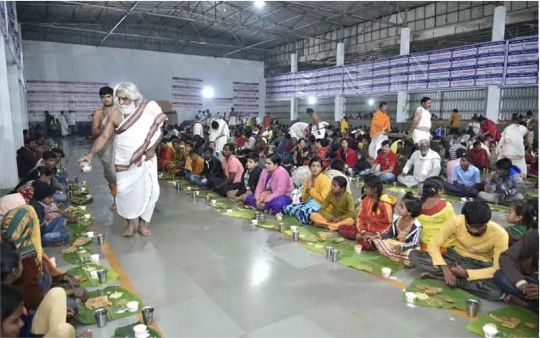

Prabhu Dwadashi
This is the second day of the Punyatithi celebrations of Shri Prabhu. Rajaopchar Mahapooja is held just as on a preceding day. Devotees gather in thousands to avail of the Maha-Prasad in the Bhandarkhana. Shreeji performs Anna-Pooja to the heap of cooked rice that is kept ready to be served as Maha-Prasad in the Bhandarkhana after the Maha-Pooja.


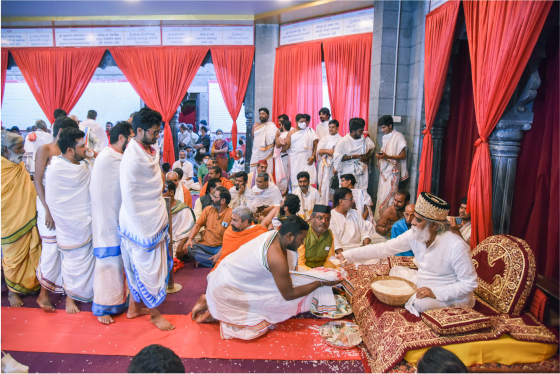
Dakshina Darbar
The week-long Datta Jayanti Celebration at Maniknagar is actually divided into two portions; the first three days of the Utsav, i.e. from Margasheersha Shuddha Ekadashi (Prabhu Punyatithi) to Dakshina Darbar (Margasheersha Shuddha Trayodashi) relate to the anniversary of Shri Prabhu’s Maha Samadhi (Punyatithi Utsav) and the later half, i.e. from Guru Poojan (Margasheersha Shuddha Chaturdashi) to Darbar (Margasheersha Vadya Pratipada) is the birth anniversary celebration (Janmotsav).Shri Prabhu, on the preceding day of his Maha-Samadhi, spent the whole day distributing alms (which, in Urdu is called khairat and in Sanskrit Dakshina) to the poor, the needy, the fakirs, the Brahmins, and the Gosais.
The Dakshina Darbar is symbolic of this last gathering that Shri Prabhu had and gave the audience to the people. To commemorate Shri Prabhu’s Punyatithi Shreeji holds the Dakshina Darbar in the early part of this day and hundreds of Fakirs, Gosais and Brahmins receive Dakshina or Khairaat from him.

Dakshina Darbar
The week-long Datta Jayanti Celebration at Maniknagar is actually divided into two portions; the first three days of the Utsav, i.e. from Margasheersha Shuddha Ekadashi (Prabhu Punyatithi) to Dakshina Darbar (Margasheersha Shuddha Trayodashi) relate to the anniversary of Shri Prabhu’s Maha Samadhi (Punyatithi Utsav) and the later half, i.e. from Guru Poojan (Margasheersha Shuddha Chaturdashi) to Darbar (Margasheersha Vadya Pratipada) is the birth anniversary celebration (Janmotsav).Shri Prabhu, on the preceding day of his Maha-Samadhi, spent the whole day distributing alms (which, in Urdu is called khairat and in Sanskrit Dakshina) to the poor, the needy, the fakirs, the Brahmins, and the Gosais. The Dakshina Darbar is symbolic of this last gathering that Shri Prabhu had and gave the audience to the people. To commemorate Shri Prabhu’s Punyatithi Shreeji holds the Dakshina Darbar in the early part of this day and hundreds of Fakirs, Gosais and Brahmins receive Dakshina or Khairaat from him.
Prabhu Jayanti
Maniknagar is the only Datta Peetha which can boast of a spiritual continuum. There has been an unbroken lineage of illustrious Acharyas on the divine Peetha (seat) of Shri Prabhu, who, in their own unique way have enriched the philosophy, the literature and the devotee-base of the Samsthan. Each of these Acharyas has extensively toured the length and breadth of the country to propagate the message of Shri Prabhu and have in the course built up a large base of followers. Even though a Sakalamati or the follower of the Sakalamat Siddhant has an all-embracing, open and holistic approach to religion and spirituality,he needs to adhere to some basic tenets of the Sampradaya as laid down by Shri Sadguru Martand Manik Prabhu Maharaj. Mantra-Deeksha or Mantropadesha, which means initiation into the
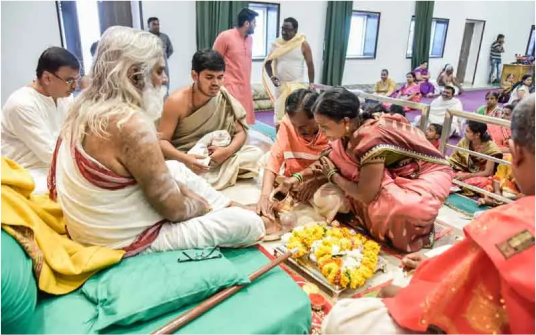
Sampradaya by way of Upadesh or passing of confidential spiritual instruction from the Guru to the Shishya is an epochal event in the life of a spiritual seeker. A shishya who receives such Upadesh or spiritual instruction from the Guru has to lead his life according to the instructions of the Guru in a pious and dutiful manner, always contemplating on the spiritual instruction received from his master.
Hundreds of devotees who have received Upadesh or Mantra-Deeksha from the Acharyas of Shri Prabhu-Sampradaya congregate at Maniknagar on this day to pay their obeisance to their Guru. Shri Maharaj Ji also gives Mantra-Deeksha or Upadesh on this day to those new devotees who come to him with a desire to be initiated into the divine order of Shri Prabhu.

Prabhu Jayanti
Maniknagar is the only Datta Peetha which can boast of a spiritual continuum. There has been an unbroken lineage of illustrious Acharyas on the divine Peetha (seat) of Shri Prabhu, who, in their own unique way have enriched the philosophy, the literature and the devotee-base of the Samsthan. Each of these Acharyas has extensively toured the length and breadth of the country to propagate the message of Shri Prabhu and have in the course built up a large base of followers. Even though a Sakalamati or the follower of the Sakalamat Siddhant has an all-embracing, open and holistic approach to religion and spirituality,he needs to adhere to some basic tenets of the Sampradaya as laid down by Shri Sadguru Martand Manik Prabhu Maharaj. Mantra-Deeksha or Mantropadesha, which means initiation into the Sampradaya by way of Upadesh or passing of confidential spiritual instruction from the Guru to the Shishya is an epochal event in the life of a spiritual seeker. A shishya who receives such Upadesh or spiritual instruction from the Guru has to lead his life according to the instructions of the Guru in a pious and dutiful manner, always contemplating on the spiritual instruction received from his master.
Hundreds of devotees who have received Upadesh or Mantra-Deeksha from the Acharyas of Shri Prabhu-Sampradaya congregate at Maniknagar on this day to pay their obeisance to their Guru. Shri Maharaj Ji also gives Mantra-Deeksha or Upadesh on this day to those new devotees who come to him with a desire to be initiated into the divine order of Shri Prabhu.
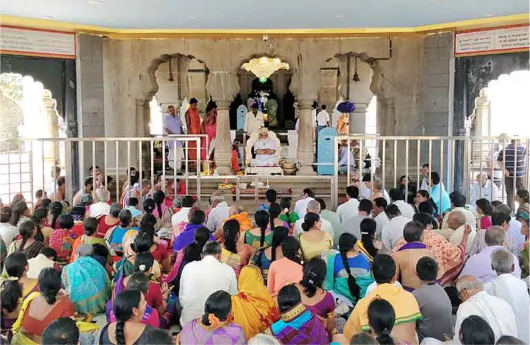
Prabhu Darbar
The Mahotsava concludes with DARBAR, which is the valedictory function of the Mahotsav. His Holiness, dressed in the traditional attire and accompanied by all the regal paraphernalia (Chatra, Chamar, Dand, etc.), ascends the silver Simhasana of Shri Prabhu Maharaj at around 11:50 p.m. The Janmotsava Celebrations of Shri Sadguru Manik Prabhu Maharaj follow immediately after His Holiness occupies the Simhasana by the singing of Aarati and showering of flowers by throngs of devotees assembled on the occasion. The Secretary of Shri Manik Prabhu Samsthan then presents an annual report of the various social, of the various social, religious, cultural and educational activities taken up by the Samsthan
during the entire year. Musical performances by renowned as well as up-coming artists continue throughout the night. This Durbar, which is truly a fitting finale to the Mahotsava concludes with a glorious procession around the temple complex and the village of Maniknagar with Shreeji settled in the historic palanquin, presented by the Shankaracharya of Shringeri. Hundreds of folk artists present various kinds of folk dances along the route of the procession.

Prabhu Darbar
The Mahotsava concludes with DARBAR, which is the valedictory function of the Mahotsav. His Holiness, dressed in the traditional attire and accompanied by all the regal paraphernalia (Chatra, Chamar, Dand, etc.), ascends the silver Simhasana of Shri Prabhu Maharaj at around 11:50 p.m. The Janmotsava Celebrations of Shri Sadguru Manik Prabhu Maharaj follow immediately after His Holiness occupies the Simhasana by the singing of Aarati and showering of flowers by throngs of devotees assembled on the occasion. The Secretary of Shri Manik Prabhu Samsthan then presents an annual report of the various social, religious, cultural and educational activities taken up by the Samsthan during the entire year. Musical performances by renowned as well as up-coming artists continue throughout the night. This Durbar, which is truly a fitting finale to the Mahotsava concludes with a glorious procession around the temple complex and the village of Maniknagar with Shreeji settled in the historic palanquin, presented by the Shankaracharya of Shringeri. Hundreds of folk artists present various kinds of folk dances along the route of the procession.

© 2024 Shri Manik Prabhu Samsthan. All Rights Reserved.
Design & Developed by Pixel N Paper
